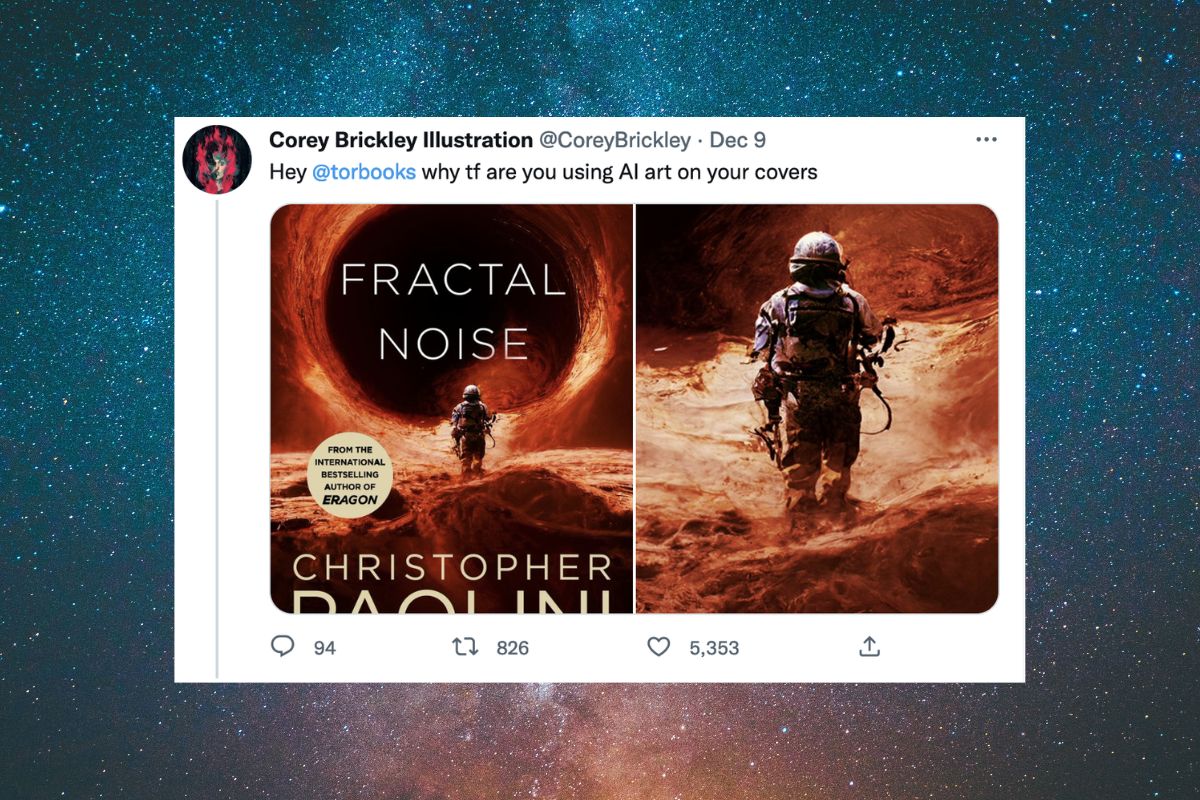Tor Faces Major Backlash for Purchasing AI Art for Upcoming Novel From Bestselling Author

Just as quickly as AI art has taken over our social media timelines, it’s now invading the book publishing space. First, there was developer Ammaar Reshi printing copies of a children’s book he made almost entirely out of AI art and text. While artists and authors rightfully called out the many issues of this book and the disturbing details kids will fixate on, it also signaled to publishing (looking to devalue their labor force even more) that this is an alternative to paying creatives. After all, Reshi made this book, from start to print, in 48 hours. Now, the reputable sci-fi and fantasy giant Tor Books (a Macmillan imprint) is coming under fire for using AI in an upcoming major release.
The comments accusing Tor of using AI art in Christopher Paolini‘s follow-up to To Sleep in a Sea of Stars, Fractal Noise, came as early as November (when the cover was revealed), but it wasn’t until December when more people realized what happened. Around December 9, pressure had built up, and those concerned demanded an answer from Tor and Paolini. On December 15, Tor released this statement on their social media:
Tor Books designed the cover for Fractal Noise by Christopher Paolini. During the process of creating this cover, we licensed an image from a reputable stock house. We were not aware that the image may have been created by AI. Our in-house designer used the licensed image to create the cover, which was presented to Christopher for approval. Due to production constraints, we have decided to move ahead with our current cover. Tor Publishing Group has championed creators in the SFF community since our founding and will continue to do so.
At first glance, it’s easy to take at least the first part of this as truth. As far back as September, stock websites and individuals began to host AI art for licensing purposes. Since then, it’s only grown, with Adobe Stock and the portfolio site Artstation catering to AI art. Shutterstock even inked a deal with AI generators in October. Between the sites hosting the images and the companies (like Tor) using them, there are no guidelines for even labeling AI art. It’s being mixed in with human-made art. The AI image created (from stolen images) for the base of Fractal Noise is not even labeled as AI created on Shutterstock.
The first three sentences of Tor’s statement are almost understandable—until you realize what illustrator Corey Brickley noted, which is that the original image is missing limbs, which were added for the book version. Someone isn’t telling the truth, be it Tor Books or the in-house team that worked on this (probably under immense pressure). Regardless, there is still no reason to go forward with this as is. If the book isn’t ready by the intended release date (May 2023), it could simply be delayed.
Artists and authors speak up against this
Tor knew they would continue to get backlash because, in that tweet, they turned off replies. Most of the people talking about it are retweets, and the conversation continues in those replies.
Some even found it to resemble art created just a few months back by artist Matt Griffen. Griffen has illustrated several covers for the Dune series, which Tor publishes. Whether or not the machine or artist knowingly emphasized to pull from Griffen’s work, this points to a large issue with AI art. It repurposes/recycles existing art and does image association with no nuance. Real artists paid to do this must consider these connections’ implications. What are the historical, sociological, cultural, political, etc. themes invoked with certain color choices, compositions, and more?
Author’s response
A common “don’t worry about it” response in terms of industry use of AI is that it will help smaller projects and those in indie companies. However, if this can be done with best-selling (of multiple titles in a 15-year span) author Christopher Paolini, this will be done with anyone, regardless of resources. Most authors have little to no say in the cover design and are lucky to get final approval.
Paolini has given mixed responses to the whole situation and has been tweeting (and replying) a lot. He spoke about the value of an artist in the book illustration process and how he’s always shared fan art of his works. Paolini commissioned work from artists and illustrated many elements of his Inheritance Saga (Eragon, etc.), including the map of Alagaësia. He also stated that this AI art situation is not ideal. Most other comments from the author remain neutral.
This is disappointing, as a reader of his books and as an artist, not to see him take a stronger stance on this, at least in a professional setting. I say professionally because he’s played with MidJourney already. However, it’s also unsurprising as, during the height of the Black Lives Matter protests in 2020, all I saw on his timeline was him promoting his book. He didn’t need to give some empty statement or anything like that, but it did leave an impression on me that this is how I found out about his new series. In a time when people were calling for collective action and for people to stand up, he seemed focused on neutrality and ignoring the world around him.
(featured image: screencap of @CoreBrickley tweet)
The Mary Sue may have advertising partnerships with some of the titles and publishers on this list.
—The Mary Sue has a strict comment policy that forbids, but is not limited to, personal insults toward anyone, hate speech, and trolling.—
Have a tip we should know? tips@themarysue.com